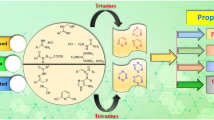Abstract
The coordination behaviour of a Schiff base with SNO donation sites, derived from condensation of 4-amino-5-phenyl-4H-1,2,4-triazole-3-thiol and salicaldehyde, towards some bi- and trivalent metal ions, namely Cr(III), Mn(II), Fe(III), Co(II) (Cl, ClO4), Ni(II) (Cl, ClO4), Cu(II), and Zn(II), is reported. The metal complexes were characterized on the basis of elemental analysis, IR, 1H NMR, solid reflectance, magnetic moment, molar conductance, and thermal analyses (TG, DTG, and DTA). The ionization constant of the Schiff base under investigation and the stability constants of its metal chelates were calculated pH-metrically at 25 °C and ionic strength µ = 0.1 M in 50% (v/v) ethanol–water mixture. The chelates were found to have octahedral (Mn(II)), trigonal bipyramidal (Co(II), Ni(II), Zn(II)), and tetrahedral (Cr(III), Fe(III), and Cu(II)) structures. The ligand and its binary chelates were subjected to thermal analyses and the different thermodynamic activation parameters were calculated from their corresponding DTG curves to throw more light on the nature of changes accompanying the thermal decomposition process of these compounds. The free Schiff base ligand and its metal complexes were tested in vitro against Aspergillus flavus, Candida albicans, C. tropicalis, and A. niger fungi and Bacillus subtilis and Escherichia coli bacteria in order to assess their antimicrobial potential. The results indicate that the ligand and its metal complexes possess antimicrobial properties.
Graphical abstract





Similar content being viewed by others
References
Wang M, Wang LF, Li YZ, Li QX, Xu ZD, Qu DQ (2001) Transition Met Chem 26:307
Gulerman NN, Rollas S, Erdeniz H, Kiraj M (2001) J Pharm Sci 26:1
Tarasconi P, Capacchi S, Pelosi G, Corina M, Albertini R, Bonati A, Dall’Aglio PP, Lunghi P, Pinelli S (2000) Bioorg Med Chem 8:154
Charo J, Lindencrona JA, Carlson LM, Hinkula J, Kiessling R (2004) J Virol 78:11321
Mishra V, Pandeya SN, Anathan S (2000) Acta Pharm Turc 42:139
Mohamed GG (2006) Spectrochim Acta A 64:188
Mohamed GG, Omar MM, Hindy AMM (2005) Spectrochim Acta A 62:1140
Mohamed GG, Sharaby CM (2007) Spectrochim Acta A 66:949
Omar MM, Mohamed GG, Ibrahim AA (2009) Spectrochim Acta A 73:358
Abdallah SM, Mohamed GG, Zayed MA, Abu Elela M (2009) Spectrochim Acta A 73:833
Mohamed GG, Abd El-Wahab ZH (2003) J Therm Anal Calorim 73:347
Mohamed GG, Omar MM, Ibrahim AA (2009) Eur J Med Chem 44:4801
Dwivedi V, Agarwal RK (1991) Indian J Pharm Sci 53:82
Mishra L, Singh VK, Dubey NK, Mishra AK (1993) Biosci Biotech Biochem 57:989
Freeman PH, Worthington PA, Rathmell WG (1982) Eur Pat Appl EP 0044:407
Hilton JL (1969) J Agric Food Chem 17:182
Joshi CK, Dubey K (1979) Phamazie 34:801
Mishra L, Said MK (1996) Indian J Chem 35A:304
Agrawal RK, Rastogi SC (1983) Thermochim Acta 63:363
Savant VV, Ramamurthy P, Patel CC (1970) J Less-Common Met 22:479
Srivastava AK, Sharma S, Agrawal RK (1982) Inorg Chim Acta 61:235
Arora K (1995) Asian J Chem 7:508
Bhave NS, Iyer VS (1987) J Therm Anal 32:1369
Calu N, Odochian L, Brinzan GL, Bilba N (1985) J Therm Anal 30:547
Naik HSB, Siddaramiah PGR, Ramappa PG (1996) Thermochim Acta 289:279
Maravalli PB, Goudar TR (1999) Thermochim Acta 325:35
Irving H, Rossotti HS (1953) J Chem Soc 3397
Irving H, Rossotti HS (1954) J Chem Soc 2904
Irving H, Williams RJP (1948) Nature 162:746
Jones RD, Summerville DA, Basolo F (1979) Chem Rev 79:139
Orgel LE (1966) An introduction to transition metal chemistry. Ligand field theory. Methuen, London
Soliman AA, Linert W (1999) Thermochim Acta 333:67
Cotton FA, Wilkinson G, Murillo CA, Bochmann M (1966) Advanced inorganic chemistry, 6th edn. Wiley, New York
Blake AJ, Lavery AJ, Schröder M (1996) Acta Crystallogr C52:37
Coats AW, Redfern JP (1964) Nature 201:68
Shukla PR, Singh VK, Jaiswal AM, Narain G (1983) J Indian Chem Soc 60:321
Omar MM, Mohamed GG, Hindy AMM (2006) J Thermal Anal Calorim 86:315
Jawetz E, Melnick JL, Adelberg EA (1979) Review of medical microbiology, 16th edn. Lang Medical, Los Angeles
Hughes WH, Stewart HC (1970) Concise antibiotic treatment. Butterworth, London, p 418
Brown NRW (1975) Resistance of Pseudomonas aeruginosa. Wiley, London
Nikaido H, Nakae T (1979) Adv Microb Physiol 20:163
Shanson DC (1989) Microbiology in clinical practice, 2nd edn. Wright, London, p 657
Sari N, Arslan S, Logoglu E, Sakiyan I (2003) Gazi Univ J Sci 16:283
Vogel AI (1962) Quantitative inorganic analysis including elemental instrumental analysis, 2nd edn. Longmans, London
Sung K, Lee AR (1992) J Heterocycl Chem 29:1102
Shawali AS, Darwish ES, Altalbawy FMA (2008) Asian J Spectrosc 11:113
Author information
Authors and Affiliations
Corresponding author
Rights and permissions
About this article
Cite this article
Altalbawy, F.M.A., Mohamed, G.G., Abou El-Ela Sayed, M. et al. Synthesis, characterization, and biological activity of some transition metal complexes with Schiff base ligands derived from 4-amino-5-phenyl-4H-1,2,4-triazole-3-thiol and salicaldehyde. Monatsh Chem 143, 79–89 (2012). https://doi.org/10.1007/s00706-011-0626-z
Received:
Accepted:
Published:
Issue Date:
DOI: https://doi.org/10.1007/s00706-011-0626-z




